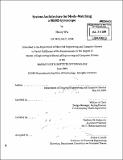| dc.contributor.advisor | William A. Clark and Vladimir M. Stojanovic. | en_US |
| dc.contributor.author | Wu, Henry, M. Eng. Massachusetts Institute of Technology | en_US |
| dc.contributor.other | Massachusetts Institute of Technology. Dept. of Electrical Engineering and Computer Science. | en_US |
| dc.date.accessioned | 2010-03-25T15:08:11Z | |
| dc.date.available | 2010-03-25T15:08:11Z | |
| dc.date.copyright | 2009 | en_US |
| dc.date.issued | 2009 | en_US |
| dc.identifier.uri | http://hdl.handle.net/1721.1/53156 | |
| dc.description | Thesis (M. Eng.)--Massachusetts Institute of Technology, Dept. of Electrical Engineering and Computer Science, 2009. | en_US |
| dc.description | Includes bibliographical references (p. 127-128). | en_US |
| dc.description.abstract | MEMS gyroscopes are used to detect rotation rates and have enabled a variety of motion-based technologies in a range of industries. They are composed of micro-machined polysilicon structures that resonate and deflect when a rotation is experienced. The topic of this thesis surrounds a system architecture to optimize the performance of a gyroscope. The MEMS gyroscope contains a resonator and an accelerometer, modeled as a two degree-of-freedom mass-spring system. When the resonant frequencies of each mode are matched, the mechanical output of the gyroscope is maximal. Feedback is used to match the two modes by automatically tuning the voltage on the poly-silicon structure until the accelerometer resonant frequency matches that of the resonator. A square wave dither signal is introduced as quadrature error and is used to track the phase across the gyroscope's accelerometer. At mode-match, the phase lag is 90°, so the feedback mechanism maintains this 90° of phase lag between the input acceleration and mechanical output to keep the modes matched. Two controllers were tried in the feedback mechanism, a linear controller and a bang-bang controller. The bang-bang controller was found to produce better results, and was able to bring a pre-fabricated sensor die to mode-match and achieve a resolution floor of 12°/hr. | en_US |
| dc.description.statementofresponsibility | by Henry Wu. | en_US |
| dc.format.extent | 128 p. | en_US |
| dc.language.iso | eng | en_US |
| dc.publisher | Massachusetts Institute of Technology | en_US |
| dc.rights | M.I.T. theses are protected by
copyright. They may be viewed from this source for any purpose, but
reproduction or distribution in any format is prohibited without written
permission. See provided URL for inquiries about permission. | en_US |
| dc.rights.uri | http://dspace.mit.edu/handle/1721.1/7582 | en_US |
| dc.subject | Electrical Engineering and Computer Science. | en_US |
| dc.title | System architecture for mode-matching a MEMS gyroscope | en_US |
| dc.type | Thesis | en_US |
| dc.description.degree | M.Eng. | en_US |
| dc.contributor.department | Massachusetts Institute of Technology. Department of Electrical Engineering and Computer Science | |
| dc.identifier.oclc | 505623828 | en_US |
